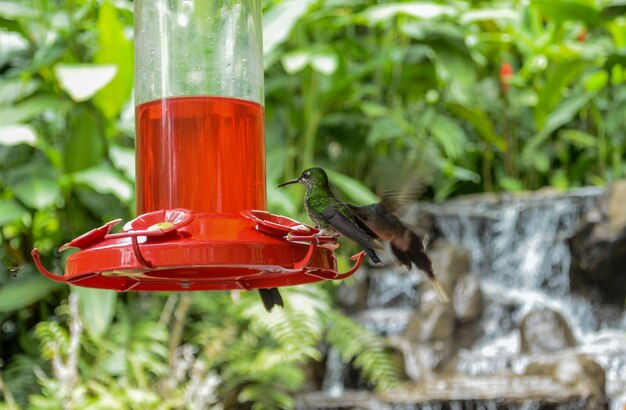How Long Can You Store Hummingbird Nectar in the Refrigerator?
Imagine the delight of watching hummingbirds flit around your backyard, their iridescent feathers catching the sun as they feed on nectar you've carefully prepared. To keep this magical experience ongoing, it's essential to store hummingbird nectar properly, ensuring it remains safe and appetizing for these tiny visitors. One common question among bird enthusiasts is: How long can hummingbird nectar last in the refrigerator? Let's dive into this topic and explore some important considerations for storing this sweet treat.
Why Proper Storage Matters
Before we talk about how long hummingbird nectar lasts, it's crucial to understand why proper storage is important. Hummingbird nectar, typically a simple mixture of water and sugar, can spoil if not stored correctly. Spoilage not only makes the solution unappealing to hummingbirds but could potentially harm them. By storing nectar properly, you ensure:
- Safety for the birds
- Preservation of nectar quality
- Reduction of waste by extending shelf life
The Basics of Hummingbird Nectar
What Is Hummingbird Nectar?
Hummingbird nectar is a straightforward concoction often made by dissolving white granulated sugar in water. The recommended ratio is generally four parts water to one part sugar. This mimics the natural sucrose content found in flower nectar, providing a quick energy source for hummingbirds.
DIY vs. Commercial Nectar
While commercial nectars are available, many experts recommend making your own. Homemade nectar is free from preservatives and artificial flavors, making it a healthier choice for birds. Plus, it's economical and easy to prepare.
Extending Nectar Shelf Life
Refrigeration: A Key Factor
When it comes to storing hummingbird nectar, refrigeration is your best friend. Refrigeration significantly extends the shelf life of the nectar by slowing bacterial growth and fermentation.
How Long Will It Last?
Typically, homemade nectar stored in a well-sealed container can last up to two weeks in the refrigerator. However, it's always a good idea to perform a quick visual and olfactory check before using it. If you notice any cloudiness, mold, or off-odors, it's time to make a fresh batch.
Tips for Optimal Storage
- Use a Clean, Sealed Container: To prevent contamination, ensure the container is thoroughly cleaned and equipped with a tight-fitting lid.
- Label Your Container: Label the container with the date you prepared the nectar to keep track of its age.
- Check Regularly: Inspect the nectar periodically for signs of spoilage.
Beyond Refrigeration: Nectar in Feeders
How Long to Keep Nectar Outside
While refrigeration extends the life of nectar inside your fridge, putting nectar outdoors in feeders presents a different scenario. Temperature and sunlight exposure significantly affect how long nectar stays fresh:
- Cooler Weather (below 70°F): Nectar should be changed every 4–5 days.
- Warmer Weather (above 70°F): Change nectar every 2–3 days.
- Hot Weather (above 90°F): Consider changing every day to avoid spoilage.
Signs of Spoilage in Feeders
Even if you follow these guidelines, it's crucial to observe the nectar for signs of spoilage, including:
- Cloudiness or a white film
- Mold or mildew
- Unpleasant, fermented odor
Importance of Clean Feeders
Feeders need regular cleaning to prevent the buildup of harmful bacteria and fungi. Use hot water and a bottle brush to scrub thoroughly, and avoid using soap, which can leave residues harmful to birds.
Practical Tips for Hummingbird Enthusiasts
To keep your nectar fresh and your feeders inviting for hummingbirds, here are some practical tips to consider:
- 🕒 Plan Ahead: Make nectar in batches that match your feeder capacity and your local hummingbird population.
- 📅 Schedule Replacements: Create a schedule for replacing nectar both in your refrigerator and feeder, tailored to your climate.
- 🏡 Position Feeders Wisely: Place feeders in shaded areas to slow nectar spoilage and attract more birds.
Quick Recap: Storing and Maintaining Nectar
| Action | Frequency/Duration |
|---|---|
| Refrigerate nectar | Up to 2 weeks |
| Change nectar (cooler) | Every 4–5 days |
| Change nectar (warmer) | Every 2–3 days |
| Change nectar (hot) | Daily |
| Clean feeders | Each time nectar is changed |
Frequently Asked Questions
Can I freeze hummingbird nectar?
While you can freeze hummingbird nectar to extend its shelf life further, be sure to use a freezer-safe container that allows for expansion. Thaw nectar in the refrigerator before use and give it a good stir to ensure even mixing.
Is there an ideal feeder type for keeping nectar fresh?
Feeders with built-in shades or those made from UV-resistant plastic can help delay nectar spoilage. Always prioritize the ease of cleaning when selecting a feeder.
What sugar should I use for nectar?
Stick to refined white sugar, as other types (such as brown or raw sugar) contain additives or impurities that can upset the delicate balance needed for hummingbirds.
Protecting Hummingbirds: A Shared Commitment
By understanding and implementing optimal storage practices for hummingbird nectar, you're not only ensuring a delightful garden show but also playing a part in the health and well-being of these mesmerizing creatures. Every small effort counts—keeping feeders clean, diligently replacing nectar, and respecting the needs of the local hummingbird population empowers you to contribute meaningfully to their thriving presence.
In essence, whether you’re a seasoned birder or a newcomer with a keen interest in wildlife, understanding how to manage hummingbird nectar properly is essential. With a little effort and attention, you can be assured that your garden is a welcoming and safe haven for hummingbirds all season long.
